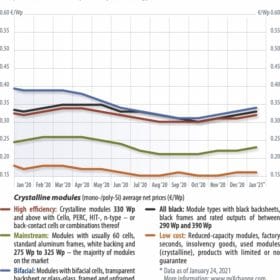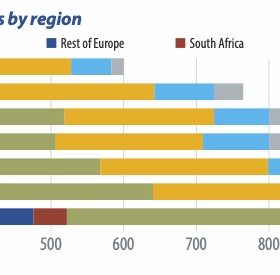Solar surges, storage up next
The forecasting of global PV installations is best done at a safe distance. The ability of PV to be installed quickly, and the spikes in installations before a certain subsidy program winds up, or when project completion is required under a tender, often results in a surge of deployment – sometimes far beyond the expectations of even the most courageous analyst.
Strong beginnings
Solar stocks enjoyed a good start in 2021, writes Jesse Pichel of ROTH Capital Partners. In the United States, the Biden administration’s focus on climate change and the expectation of further incentives for renewables saw solar stocks rally in January. The global forecast is also positive, with China and others set for big installation numbers.
A wrench in the works
Looking back at the past year, the renewables sector has seen two extremes. In Germany, disparities were triggered in part by the recently passed amendment to the Renewable Energy Sources Act (EEG). For solar PV in particular, the pendulum will swing in favor of installers of small systems in the near term, writes Martin Schachinger of pvXchange. For installations up to 30 kWp, the new law has cleared market barriers.
Growth continues despite Covid-19 headwinds
The global residential energy storage market continued to grow in 2020, writes IHS Markit Analyst Michael Longson. Many suppliers were looking to build upon a strong first quarter when Covid-19 hit in March 2020 and slowed the market significantly. However, as a result of several funding packages being introduced and the gradual easing of local restrictions, shipments continued to grow throughout the second and third quarters, enabling strong year-on-year growth for the sector in 2020.
Global PV installations to surpass 150 GW in 2021
Despite pandemic-induced impacts, the PV market was bigger than expected last year. In particular, an installation rush in Vietnam and China took place in December and pushed global demand upward. PV InfoLink estimates that global module demand in 2020 reached 140 GW. Analyst Mars Chang delves into the numbers.
New EU battery rules support a sustainable industry
On Dec. 10, European Internal Market and Environment Commissioners Thierry Breton and Virginijus Sinkevičius, in conjunction with Vice President Maroš Šefčovič, announced a keenly anticipated piece of legislation: the commission’s proposal for modernized EU battery rules. Pia Alina Lange – head of communications for Recharge, the European battery industry association – says that while there are potential pitfalls with the new regulation, it could pave the way to sustainable industry development.
New partnership to drive EU battery innovation
The Batteries European Partnership Association is now up and running. Partnering with the EU will drive research activities and innovation to support a competitive, sustainable, and circular European battery value chain, writes Michael Lippert, who currently leads product and market strategy for Saft Energy Storage Systems.
What Asia needs to turn away from coal
Given the rapid decrease of the solar electricity cost, pv magazine explores the drivers and obstacles behind switching off coal and embracing photovoltaics and other renewable energy technology in Asia. The good news: things are moving in the right direction.
US storage goes mega-scale
In the midst of a still-surging Covid-19 pandemic, the U.S. energy storage market is booming, driven by utility procurement of increasingly large projects well beyond the 100 MW mark. The industry is clearly focused, and seemingly unified, on the need for wide and rapid deployment. But a key question for the U.S. market is whether policy, regulation, and the supply chain can keep up.
The big PV switch-off
South Australia is leading the nation in terms of renewable energy penetration, with rooftop solar a major contributor. But the state’s hard-won ability to deactivate thousands of rooftop solar systems in response to grid voltage disturbances has caused significant disruptions to solar installers. With a deeper look inside the changes, it appears to be a good thing for solar in the state, as well as other markets in which distributed PV is growing rapidly.










